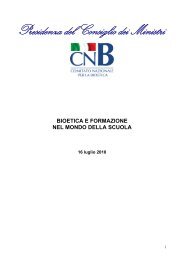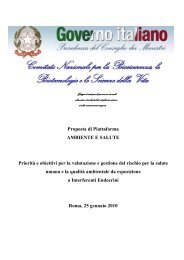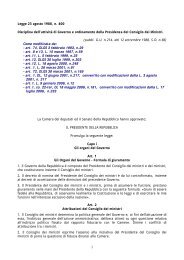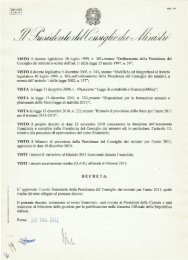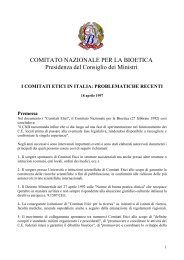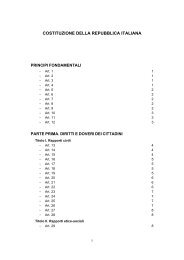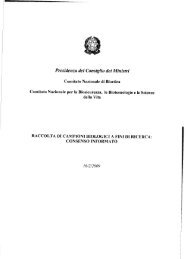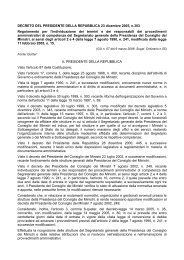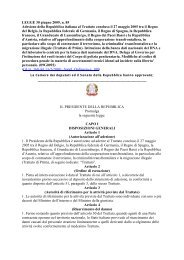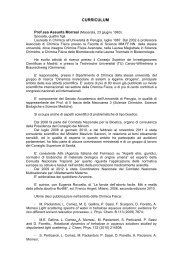President
President
President
You also want an ePaper? Increase the reach of your titles
YUMPU automatically turns print PDFs into web optimized ePapers that Google loves.
history 121 : if in the past children with this condition were not operated on,<br />
however since the 1950’s medical practice has also begun to provide surgical<br />
intervention and has subsequently taken different directions.<br />
5.1 In the 50’s there was the spread of the theories of J. Money which had<br />
an impact in the development of the bioethical guidelines mentioned later in this<br />
opinion. Money affirms the irrelevance of genetic and gonadal sexual identity,<br />
in the belief that sexual identity (defined as “gender” to distinguish it from the<br />
bodily identity) derives from the psychic structure induced as a consequence by<br />
family education and socialization. In his opinion, the development of gender<br />
identity is a kind of “psychic imprinting” completed within two and a half years<br />
from birth and that can be changed later but with serious risks for psychological<br />
equilibrium 122 . Money’s perspective marks a critical somatic step (or somatic<br />
prevalence) towards pragmatic criterion, that is, the criterion of sexual<br />
assignment by the physician on the basis of surgical feasibility: in cases of<br />
ambiguity, given the complexity of reconstruction of functional male genitalia, it<br />
was preferred to assign female sex to the subject, with a corresponding<br />
upbringing, regardless of consideration of the physical indices (but also of<br />
possible infertility or sexual satisfaction). Money’s indication was therefore that<br />
of early assignment, in order to facilitate “oriented” nurture, even with<br />
intervention for demolition and reconstruction and possible hormonal therapy at<br />
pubertal age.<br />
It should be mentioned that after World War II, the most discerning work in<br />
depth psychology - let us think to W.R. Bion or to D. Winnicot 123 - genuinely<br />
tried to understand the influence of the unconscious and cultural formation,<br />
without any denial of the genetic component in the construction of sexual<br />
identity. The model supported by Money was criticised 124 regarding the<br />
malleability of gender identity. Clinical and scientific evidence have challenged<br />
the model of absolute gender malleability. At the clinical level 125 , the serious<br />
distress experienced by some of the cases treated (feminized males asked to<br />
121<br />
A.D. Dreger, A history of intersexuality: from the age of gonads to the age of consent, “J.<br />
Clin. Ethics”, 1998, 9, pp. 345-349.<br />
122<br />
Cf. A.D. Dreger, Ambiguous sex or ambivalent medicine? Ethical issues in the treatment of<br />
intersexuality, “Hastings Center Report”, 1998, May-June, pp. 24-35.<br />
123<br />
D. Winnicot, Playing and Reality preface by R.Gaddini, Armando, Rome 1974 and Sulla<br />
natura umana edited by R. Gaddini, Cortina, Milan 1990; W.R.Bion, The Italian Seminars, Borla<br />
1985 and Attention and interpretation Tavistok Publications, London 1970.<br />
124<br />
Included in the criticism is the possible damage from surgical practice (loss of reproductive<br />
ability, infections, pain, distress, incontinence); the possible strengthening of the social<br />
perception of “sexual abnormality”; asymmetry in the treatment of male and female (the choice<br />
of assignment as male was measured on the basis of the possibility to have sexual satisfaction;<br />
the choice of assignment as female on the basis of the capability to copulate). K. Kipnis, M.<br />
Diamond, Pediatric ethics and the surgical assignment of sex, “The Journal of Clinical Ethics”,<br />
1998, 9, 4, pp. 398-410; H.G. Beh, M. Diamond, An emerging ethical and medical dilemma:<br />
should physicians perform sex assignment surgery on infants with ambiguous genitalia?, “Mich.<br />
J. Gender Law”, 2000,, pp. 7-38.<br />
125<br />
Reiner reported a study of 27 children: 25 males who were raised as females, 14 declared<br />
themselves to be male. W. Reiner, To be male or female: that is the question, “Arch. Pediatr.<br />
Adolescent Med”, 1997, 151, p. 224; Id, Case study: sex reassignment in a teenage girl, “J. Am<br />
.Acad. Child. Adolesc. Psychiatry”, 1992, 35 (6), pp. 799-803; Id. Sex assignment in the<br />
neonate with intersex or inadequate genitalia, “Am. J. Dis. Child”, 1990, pp. 1044; Id, Androgen<br />
exposure in utero and the development of male gender identity in genetic males reassigned at<br />
birth, Presented at international Behavioural Development Symposium 2000, May 25-27, 2000;<br />
Id., Gender identity: study questions `sex reassignment`, “Health Med”, May 16, 2000, A17.<br />
92




